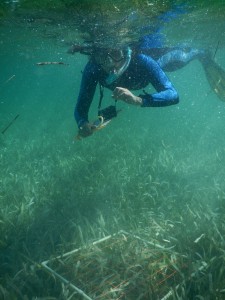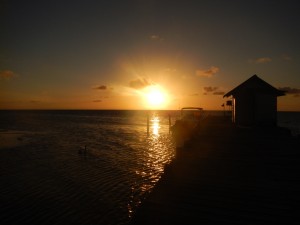Our first day out on the reef started with a scavenger hunt. We search for all sorts of reef creatures and their various interactions on the patch reef just beyond the island. Many species of herbivorous fish feed on algae here; I was able to spot another blue tang surgeonfish and several species of damselfish. Damselfish can be seen patrolling their gardens, which are small patches of algae that they feed on. I found cocoa damselfish (Stegastes variabilis), dusky damselfish (Stegastes fuscus), and threespot damselfish (Stegastes planifrons). The patch reef also contained a number of initial phase striped parrotfish (Scarus croicensis) and even a brightly colored stoplight parrotfish (Sparisoma viride).

The real science started when we learned the art of using transects and quadrats to collect quantitative data on the reef. We began on land and then transitioned to an exploratory study of green algae (spoiler alert: we didn’t find any).
We finished the day with a visit to what can only be described as a coral graveyard. Coral skeletons litter the shore of Middle Caye, their polyps perfectly preserved due to mineralization. We studied the common reef species, using the dead corals to learn their morphologies and create a search image for the reef. Though I’ve visited reefs before, I’ve never been able to do much more than say that corals are colorful. Thanks to our grave digging adventure, I’m now able to appreciate the diversity of corals and might even be able to name some of them.

And then, with a beautiful sunset in the background, our first day at the reef was done.
